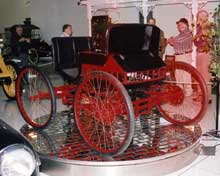On Independence Day 1894, Elwood Haynes took his new car for a ride. Haynes, of Kokomo, Indiana, had the car, which he designed and had built over the previous winter, towed out to the country behind a team of horses, so as not to cause a commotion in town. It started easily, and took the pioneering engineer for a short ride on Pumpkinvine Pike. The car seen here is a replica, currently at Kokomo’s Automotive Heritage Museum; the original is in the Smithsonian Institution.
Haynes was firmly of the opinion that he had invented the automobile, reportedly oblivious to the fact that J. Frank Duryea had made a similar excursion the previous autumn in Springfield, Massachusetts (or even fellow Hoosier John Lambert, whose motor tricycle was on the road in 1891). With his successful ride behind him, Haynes teamed with the Apperson brothers, who had built his car, to produce the Haynes-Apperson car for sale to the public. The Appersons soon split to build a car under their own name, which they did until 1926, using as a mascot the impudent jackrabbit. Haynes, meanwhile, continued in production making successively larger automobiles, billed as “America’s First Car.” Six cylinder cars were joined by a Light Twelve for 1917 to 1922. The last Haynes cars were built in 1925, the year Elwood died.
Today, Kokomoans refer to the Haynes as “America’s First Mechanically Successful Automobile,” on the basis that the Duryea’s production history was peripatetic and short. Elwood Haynes’ accomplishments, though, are legion, and are celebrated at the Elwood Haynes Museum, located in Haynes’ last dwelling on South Webster Street. On display is a 1905 Model L Haynes car, a sophisticated machine with tilt steering wheel and well-balanced two-cylinder midship engine. On a recent visit, Society of Automotive Historians directors Arthur Jones and Joe Freeman gave it thorough scrutiny.
Elwood Haynes’ lasting legacies, though, are his metallurgical inventions, stellite and stainless steel. A successor company, Haynes International, Inc., headquartered in Kokomo, produces them, along with other nickel- and cobalt-based alloys. Kokomo’s industrial heritage also includes tires, canned tomato juice and the mechanical corn picker.
Pumpkinvine Pike is now called East Boulevard, but the section on which Elwood rode is still a country road. A monument to his feat is located in front of the Foursquare Gospel Church, proclaiming it the “birthplace of a new era.”

